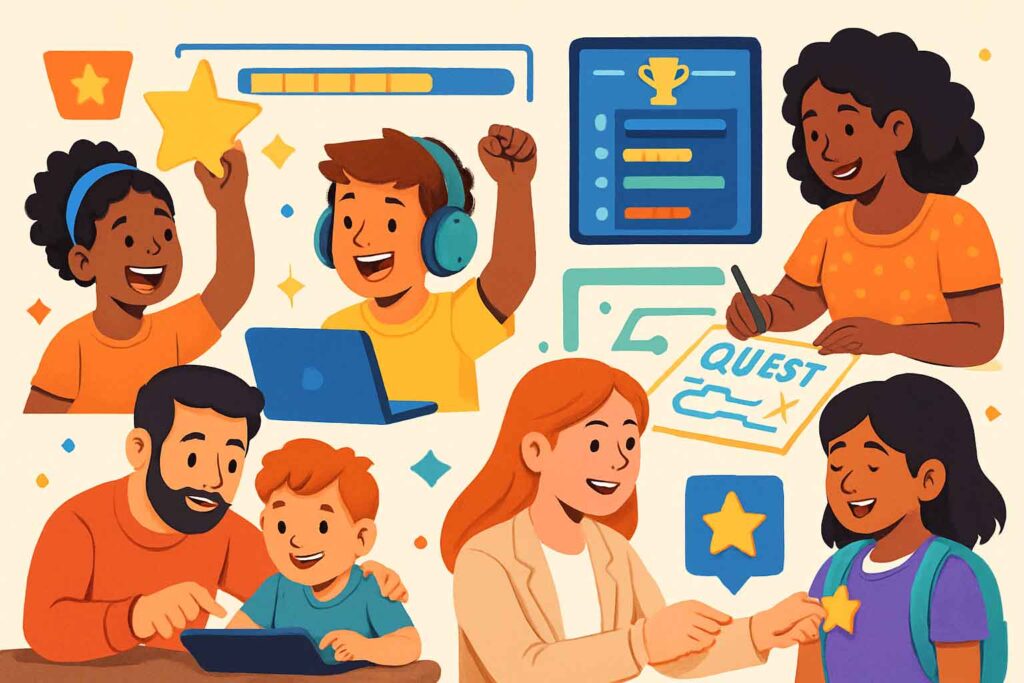Introduction
In an era dominated by digital entertainment, capturing and sustaining children’s attention can be a significant challenge for educators and parents alike. Enter gamification – the strategic integration of game-like elements and principles into non-game contexts, particularly education. Far from merely playing games, gamification in learning harnesses the inherent appeal of challenges, rewards, and progress to transform traditional educational experiences into engaging, motivating, and highly effective journeys. This article will explore the profound impact of gamification on learning, its core mechanics, and practical ways for parents and teachers to implement it to foster a love for lifelong learning.
What is Gamification in Education?
Gamification is not about replacing traditional learning with video games. Instead, it’s about applying the motivational psychology and design techniques found in games to educational activities. Think of it as making learning feel like a game, even when it’s not. Key elements often include:
•Points: Awarded for completing tasks, demonstrating understanding, or participating.
•Badges: Digital or physical awards for achieving specific milestones or mastering skills.
•Leaderboards: Displaying progress and fostering healthy competition among learners.
•Levels: Structuring learning into progressive stages, each with increasing difficulty or new challenges.
•Quests/Missions: Framing learning objectives as specific tasks or challenges to be completed.
•Rewards: Tangible or intangible incentives for success, such as virtual currency, extra playtime, or recognition.
•Narrative/Storytelling: Embedding learning within an engaging story that gives purpose to tasks.
•Immediate Feedback: Providing instant information on performance, allowing for quick adjustments and reinforcement.
Why Gamification Works: The Psychology Behind the Play
The effectiveness of gamification stems from its ability to tap into fundamental human psychological drivers:
1. Motivation and Engagement
Games are inherently motivating. By incorporating elements like points and levels, gamification transforms mundane tasks into exciting challenges. The anticipation of rewards and the desire to progress keep learners engaged and eager to continue.
2. Sense of Achievement and Mastery
Successfully completing a level or earning a badge provides a tangible sense of accomplishment. This reinforces learning and builds confidence, encouraging children to tackle more complex tasks and strive for mastery.
3. Immediate Feedback and Iteration
Unlike traditional assessments that might come days or weeks later, gamified learning often provides instant feedback. This allows children to understand their mistakes immediately, learn from them, and try again, fostering a growth mindset and resilience.
4. Autonomy and Choice
Many gamified systems offer choices in how tasks are approached, what challenges to undertake, or the order of learning. This sense of autonomy empowers learners, making them feel more in control of their educational journey.
5. Social Connection and Collaboration
Leaderboards can foster friendly competition, while team-based quests encourage collaboration and peer learning. This social aspect makes learning more dynamic and enjoyable.
6. Fun and Enjoyment
Ultimately, gamification makes learning fun. When children enjoy what they are doing, they are more likely to be engaged, retain information, and develop a positive attitude towards education.
Practical Applications for Parents and Teachers
Implementing gamification doesn’t require complex software or extensive resources. Many elements can be integrated into daily routines and lessons:
For Parents:
•Chore Charts as Quests: Turn household chores into a game with points, levels, and rewards (e.g., screen time, a special outing).
•Reading Challenges: Create a reading
log with points for each book read, or a “reading quest” with different genres as levels.
•Learning Apps with Gamified Features: Many educational apps already incorporate gamified elements. Encourage their use and discuss progress with your child.
•Family Game Nights: Reinforce the fun of learning through games by regularly engaging in educational board games or card games.
•Positive Reinforcement: Use praise and small, meaningful rewards to acknowledge effort and progress, just like in a game.
For Teachers:
•Design Learning Units as Quests: Frame a unit of study as a grand quest with a clear objective, sub-quests (lessons), and challenges (assignments).
•Implement Point Systems and Badges: Award points for participation, correct answers, completed assignments, and positive behavior. Create digital or physical badges for mastering specific skills or concepts.
•Use Leaderboards (Carefully): While leaderboards can motivate, ensure they are used in a way that promotes healthy competition and celebrates individual progress, not just top performers. Consider team-based leaderboards.
•Create Escape Rooms or Breakouts: Design classroom activities where students must solve a series of puzzles and challenges to “escape” or “break out,” reinforcing curriculum content.
•Integrate Digital Tools: Utilize online platforms and apps specifically designed for gamified learning, such as Kahoot!, ClassDojo, or learning management systems with gamification features.
•Provide Choice and Autonomy: Allow students to choose how they demonstrate their learning, or offer different pathways to achieve a learning objective.
•Focus on Feedback: Ensure feedback is immediate, constructive, and helps students understand how to improve, mirroring the instant feedback in games.
Potential Challenges and Considerations
While gamification offers immense potential, it’s important to be mindful of potential pitfalls:
•Over-reliance on External Rewards: The goal is to foster intrinsic motivation, not just reliance on points or badges. Gradually shift focus from external rewards to the joy of learning itself.
•Meaningful Gamification: Ensure that game elements are integrated meaningfully and enhance learning, rather than being superficial additions that distract from the educational content.
•Equity and Inclusion: Design gamified systems that are accessible and motivating for all learners, considering different learning styles and needs.
•Teacher Training: Educators need proper training and support to effectively design and implement gamified learning experiences.
Conclusion
Gamification is more than just a trend; it’s a powerful pedagogical approach that can revolutionize how children learn. By tapping into the innate human desire for challenge, progress, and achievement, gamification transforms education into an exciting and engaging adventure. For parents and teachers, embracing gamified strategies means fostering a generation of motivated, resilient, and lifelong learners who are not just acquiring knowledge, but actively enjoying the process of discovery. Let’s level up learning together and unlock the full potential of every child through the power of play.
